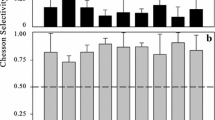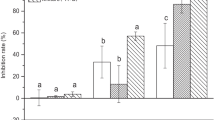Abstract
A dense bloom of a green algae was reduced by 97% within 5 days. This was probably caused by grazing by a colourless flagellate that increased logarithmic to high number under these days and disappeared as quickly. After this the green algae increased rapidly and mucilage lumps excreated by the flagellate was colonized by a specialistChlomydomonas.
The flagellate attack was probably enhanced by the high cell density and the physiological weakness of the green algae, due to a very low growth caused by shortage of inorganic carbon. The grazing seems to have caused an increase of inorganic nutrients that promoted the following growth of the green algae.
Similar content being viewed by others
References
Banse, E.: Cell volume, maximal growth rate of unicellular algae and ciliates, and the role of ciliates in the marine pelagial. Limnol. Oceanogr.27, 1059–1071 (1982).
Björk-Ramberg, S.: Changes in sediment nutrient content in a subarctic lake subject to lake fertilization. Freshw. Biol.14, 157–164 (1984).
Canter, H. M., and Lund, J. W. G.: Studies on plankton parasites. I. Fluctuations in the numbers ofAsterionella formosa Hass. in relation to fungal epidemics. New Phytol.47, 238–261 (1948).
Curds, C. R.: Microbial interactions involving protozoa. In: Skinner, F. A., and Shewan, J. M. (eds): Aquatic Microbiology, p. 69–105. Academic Press, London 1977.
Fenchel, T.: The quantitative importance of the benthic microfauna of an arctic tundra pond. Hydrobiologia46, 445–464 (1975).
Fenchel, T.: Ecology of heterotrophic microflagellates. I. Some important forms and their functional morphology. Mar. Ecol. Prog. Ser.8, 211–223 (1982).
Fenchel, T.: Ecology of heterotrophic microflagellates. III. Adaptions to heterogeneous environments. Mar. Ecol. Prog. Ser.9, 25–33 (1982).
Fenchel, T.: Ecology of heterotrophic microflagellates. IV. Quantitative occurrence and importance as bacterial consumers. Mar. Ecol. Prog. Ser.9, 35–42 (1982).
Hellebust, J. A.: Extracellular products. In: Stewart, W. D. P. (ed.): Algal Physiology and Biochemistry, p. 838–863. Blackwell, Oxford 1984.
Holmgren, S.: Fytoplankton; Gunillajaure 1978 och 1979. Kuokkelprojektens rapport7, 59–62. Mimeographed. Institute of Limnology, Uppsala, Sweden 1980.
Jansson, M.: Abiotiska förhållanden i Gunillajaure 1977. Kuokkelprojektens rapport6, 6–23. Mimeographed. Institute of Limnology, Uppsala, Sweden 1980.
Jansson, M.: Abiotiska förhållanden i Gunillajaure 1978 och 1979. Kuokkelprojektens rapport7, 5–25. Mimeographed. Institute of Limnology, Uppsala, Sweden 1980.
Javornicky, P., and Prokesova, V.: The influence of protozoa and bacteria upon the oxidation of organic substances in water. Intern. Rev. ges. Hydrobiol.48, 335–350 (1963).
Johannes, R. E.: Influence of marine protozoa on nutrient regeneration. Limnol. Oceanogr.10, 434–442 (1965).
Lundgren, A.: Växtplanktons produktion och klorofyll i Gunillajaure 1978 och 1979. Kuokkelprojektens rapport7, 63–80. Mimeographed. Institute of Limnology, Uppsala, Sweden 1980.
Mullin, M. M., Sloan, P. R., and Eppley, R. W.: Relationship between carbon content, cell volume, and area in phytoplankton. Limnol. Oceanogr.11, 307–311 (1966).
Nauwerck, A.: Die Beziehungen zwischen Zooplankton und Phytoplankton im See Erken. Symb. bot. Upsal.17(5), 1–163 (1963).
Pringsheim, E. G.: Farblose Algen. VEB Gustav-Fischer-Verlag, Jena 1963.
Provasoli, L., and Carlucci, A. F.: Vitamines and growth regulators. In: Stewart, W. D. P. (ed.): Algal Physiology and Biochemistry, p. 741–784. Blackwell, Oxford 1974.
Ramberg, L.: Relations between phytoplankton and environment in two Swedish forest lakes. Scr. limnol. upsal.426, 1–97 (1976).
Ramberg, L.: A population dynamics model forOocystis parva (Chlorophyceae). Arch. Hydrobiol.89, 118–134 (1980).
Sherr, B. F., Sherr, E. B., and Berman, T.: Decomposition of organic detritus: A selective role for microflagellate protozoa. Limnol. Oceanogr.27, 765–769 (1982).
Skuja, H.: Taxonomische und biologische Studien des Phytoplanktons schwedischer Binnengewässer. Nova Acta R. Soc. Scient. upsal. (Ser. 4),16/3, 1–400 (1956).
Author information
Authors and Affiliations
Rights and permissions
About this article
Cite this article
Ramberg, L. Grazing by a colourless flagellate on a green algal bloom. Schweiz. Z. Hydrol 49, 294–302 (1987). https://doi.org/10.1007/BF02538290
Received:
Issue Date:
DOI: https://doi.org/10.1007/BF02538290




